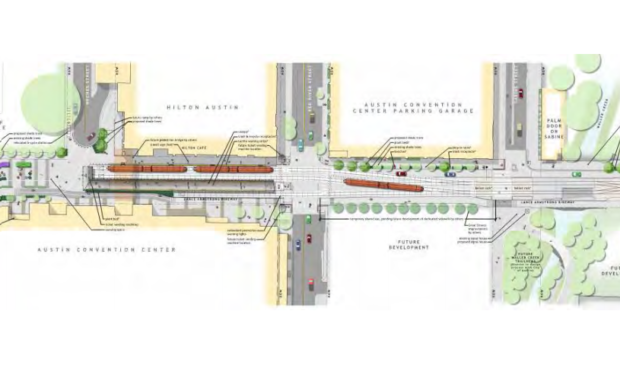Capital Metro’s Downtown Station plans inch forward
Tuesday, May 23, 2017 by
Caleb Pritchard The Capital Metropolitan Transportation Authority’s Board of Directors moved forward on Monday with plans to rebuild the downtown MetroRail station, but the long-planned project still has to clear several more hurdles until the shovels hit the ground.
At its monthly meeting, the board unanimously voted to give CEO Linda Watson permission to execute an interlocal agreement with the city of Austin that would allow Capital Metro to design and build the new station on West Fourth Street between Trinity Street and I-35.
Earlier this month, City Council granted its approval to the agreement and took steps to remove car traffic from the site in order to allow for two permanent platforms and three sets of railroad tracks.
Capital Metro is using $22 million from a state grant to replace the existing station, which the agency said was originally built as a temporary stop-gap when MetroRail first launched in 2010.
On Monday, project manager Marcus Guerrero said the the station designs are 60 percent completed. He also addressed a key element that caused no minor contention at Council. Guerrero told the board that assertions that Capital Metro had reversed itself on plans to install public restrooms at the station were a matter of “misinformation.”
“Actually, that was not the case,” Guerrero said. “We just want to clarify that public restrooms were never part of the actual drawings.”
He explained that restrooms were originally part of an “initial wish list” compiled from public feedback. He added that the plans do not allow enough space near the platforms for restrooms, but that the agency is willing to work with the city to locate the facilities “somewhere else in the public space” nearby.
Another wrinkle that needs to be ironed out is a huge infrastructure replacement project necessitated by the installation of the new station. The city is requiring Capital Metro to upgrade a large drainage pipe that runs from Trinity Street to Waller Creek, a piece of infrastructure that is not entirely within the footprint of the downtown station.
Guerrero reported to his board the hesitation among some Council members to waive costly permitting fees for that work. While he declined to give a ballpark estimate of how high those fees could total up, Guerrero told reporters afterwards that the sum could be significant.
Council Member Ann Kitchen downplayed his concerns, telling her board colleagues, “I would like everyone to understand that there is a far cry between a few of members of the Council expressing concern and any speculation about what Council will do.”
 The only question about the station designs came from Board Member Terry Mitchell, who expressed some skepticism about the canopy design that Guerrero labeled the staff favorite.
The only question about the station designs came from Board Member Terry Mitchell, who expressed some skepticism about the canopy design that Guerrero labeled the staff favorite.
The design, one of three options that has been shopped around at public forums, features a collection of canopies that resemble broken umbrellas.
“In general this is the one that’s risen to the top from the feedback we’ve received, either from internal staff or city staff or community folks,” Guerrero said.
Mitchell questioned whether the design provided the same shade and protection from the elements as the other two candidates, which both feature a single arching roof structure. Staff is still tweaking the designs, Guerrero told Mitchell.
Afterward, he explained to reporters that the canopies are being designed to prioritize keeping passengers dry rather than keeping the sun off of them.
“The convention center casts a lot of shade in that zone anyway,” he said.
After the vote to approve the interlocal agreement, board Chair Wade Cooper thanked agency staff for continuing to push the project along.
“It’s the most important public transit project, I think, that’s probably ever happened in the city of Austin,” Cooper declared. “And I hope that we can join hands with the city and really make this live up to what our community deserves and expects.”
Council Member Delia Garza was absent.
Renderings courtesy of Capital Metro.
The Austin Monitor’s work is made possible by donations from the community. Though our reporting covers donors from time to time, we are careful to keep business and editorial efforts separate while maintaining transparency. A complete list of donors is available here, and our code of ethics is explained here.
You're a community leader
And we’re honored you look to us for serious, in-depth news. You know a strong community needs local and dedicated watchdog reporting. We’re here for you and that won’t change. Now will you take the powerful next step and support our nonprofit news organization?







